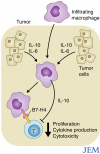New battlefields for costimulation
- PMID: 16606678
- PMCID: PMC2118297
- DOI: 10.1084/jem.20060219
New battlefields for costimulation
Abstract
Costimulation regulates the activation of naive T cells as they first encounter antigens in the secondary lymphoid organs. But recently characterized costimulatory molecules of the B7 family appear to have roles beyond initial T cell activation. New evidence shows that negative costimulators expressed by tumors and normal tissues afford local protection from T cell-mediated attack.
Figures


Comment on
-
B7-H4 expression identifies a novel suppressive macrophage population in human ovarian carcinoma.J Exp Med. 2006 Apr 17;203(4):871-81. doi: 10.1084/jem.20050930. Epub 2006 Apr 10. J Exp Med. 2006. PMID: 16606666 Free PMC article.
-
Tissue expression of PD-L1 mediates peripheral T cell tolerance.J Exp Med. 2006 Apr 17;203(4):883-95. doi: 10.1084/jem.20051776. Epub 2006 Apr 10. J Exp Med. 2006. PMID: 16606670 Free PMC article.
References
-
- Greenwald, R.J., G.J. Freeman, and A.H. Sharpe. 2005. The B7 family revisited. Annu. Rev. Immunol. 23:515–548. - PubMed
-
- Watanabe, N., M. Gavrieli, J.R. Sedy, J. Yang, F. Fallarino, S.K. Loftin, M.A. Hurchla, N. Zimmerman, J. Sim, X. Zang, et al. 2003. BTLA is a lymphocyte inhibitory receptor with similarities to CTLA-4 and PD-1. Nat. Immunol. 4:670–679. - PubMed
-
- Sedy, J.R., M. Gavrieli, K.G. Potter, M.A. Hurchla, R.C. Lindsley, K. Hildner, S. Scheu, K. Pfeffer, C.F. Ware, T.L. Murphy, and K.M. Murphy. 2005. B and T lymphocyte attenuator regulates T cell activation through interaction with herpesvirus entry mediator. Nat. Immunol. 6:90–98. - PubMed
-
- Suh, W.K., B.U. Gajewska, H. Okada, M.A. Gronski, E.M. Bertram, W. Dawicki, G.S. Duncan, J. Bukczynski, S. Plyte, A. Elia, et al. 2003. The B7 family member B7-H3 preferentially down-regulates T helper type 1-mediated immune responses. Nat. Immunol. 4:899–906. - PubMed
-
- Prasad, D.V.R., T. Nguyen, Z. Li, Y. Yang, J. Duong, Y. Wang, and C. Dong. 2004. Mouse B7-H3 is a negative regulator of T cells. J. Immunol. 173:2500–2506. - PubMed

